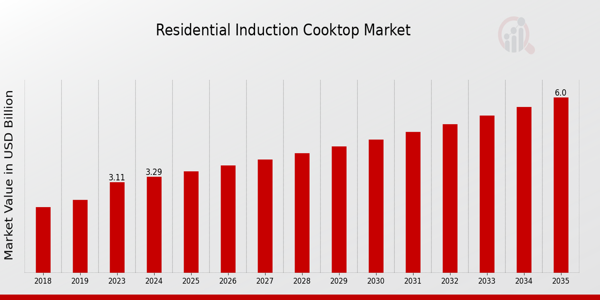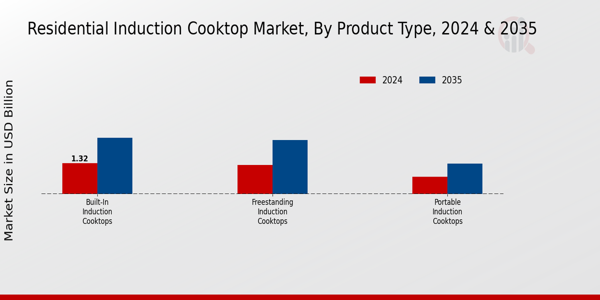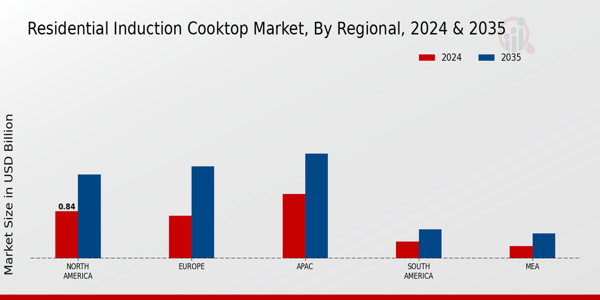Global Residential Induction Cooktop Market Overview
As per MRFR analysis, the Residential Induction Cooktop Market Size was estimated at 3.11 (USD Billion) in 2023.
The Residential Induction Cooktop Market is expected to grow from 3.29 (USD Billion) in 2024 to 6.0 (USD Billion) by 2035. The Residential Induction Cooktop Market CAGR (growth rate) is expected to be around 5.62% during the forecast period (2025 - 2035).
Key Residential Induction Cooktop Market Trends Highlighted
Numerous important reasons have contributed to the notable rise of the Residential Induction Cooktop Market. The use of contemporary kitchen equipment and growing awareness of energy efficiency have been key factors in driving this industry.
Induction cooktops are the ideal answer to consumers' growing demands for quicker cooking times and higher energy efficiency.
Additionally, there is a growing need for portable and adaptable cooking solutions due to urbanization and smaller living areas. Consumers are drawn to induction cooking because of its built-in safety measures, such as its ability to reduce heat emissions during cooking.
There are a lot of market opportunities that producers and suppliers can take advantage of. The integration of smart and connected induction cooktops, which enable remote operation and programmable settings, is made possible by the expanding trend of smart homes.
Furthermore, product innovation, including advancements in design, price diversification, and the introduction of new features, can attract a broader customer base.
Additionally, as consumers become more environmentally conscious, focusing on sustainable production practices and materials can enhance brand loyalty and consumer trust. In recent times, a noticeable trend has been the increasing incorporation of technology in kitchen appliances.
The demand for induction cooktops is also being fueled by the introduction of more aesthetically pleasing designs to blend seamlessly into modern kitchens.
Moreover, the ongoing impact of the COVID-19 pandemic has led people to rethink their cooking habits and kitchen setups, further shifting preferences towards induction cooking as a cleaner and more efficient alternative. Overall, the market dynamics are evolving, presenting a landscape ripe with opportunities and innovations yet to be explored.

Residential Induction Cooktop Market Drivers
Increasing Consumer Demand for Energy-Efficient Cooking Solutions
In an era where sustainability and energy efficiency are becoming increasingly important, many consumers are actively seeking out cooking methods that are both environmentally friendly and cost-effective.
The Residential Induction Cooktop Market is seeing a surge in demand as more individuals become aware of the benefits of induction cooking, which uses electromagnetic energy to directly heat pots and pans. This method significantly reduces energy loss compared to traditional gas and electric cooking methods, making it an appealing option for environmentally conscious consumers.
Additionally, as advancements in technology continue to improve the performance and accessibility of induction cooktops, homeowners are more inclined to invest in these efficient cooking solutions.
The rising concern over energy costs and the growing trend towards eco-friendly appliances further reinforces this demand, and as the Residential Induction Cooktop Market continues to expand, it is likely to play a crucial role in shaping the future of residential cooking appliances.
Furthermore, the convenience factor associated with induction cooking, such as faster heat-up times and precise temperature control, adds to its allure, making it a preferred choice for modern households.
With the market projected to experience a substantial increase in value by 2035, driven by the demand for energy-efficient solutions, it is clear that the shift toward induction cooktops is not merely a trend but a potential long-term preference among consumers.
Technological Advancements and Innovations
The Residential Induction Cooktop Market is being significantly driven by ongoing technological advancements and innovations in induction cooking technology.
Manufacturers are continually striving to enhance the functionality, safety, and attractiveness of induction cooktops. This includes the development of smart induction cooktops that integrate with modern home automation systems, allowing users to control their cooking remotely via smartphones or tablets.
Features like touch controls, automated timers, and safety locks are also becoming standard. By providing consumers with ease of use and enhanced cooking experiences, these innovations contribute to the growing popularity of induction cooktops.
Enhanced designs and user-friendly interfaces have made induction cooking more accessible to a wider audience, which further propels market growth.
Shifting Consumer Preferences Toward Modern Kitchen Appliances
As lifestyles evolve, consumers are increasingly favoring modern and stylish kitchen appliances that not only enhance their cooking experience but also elevate the aesthetic of their kitchens.
The Residential Induction Cooktop Market is benefitting from this shifting preference, as induction cooktops offer sleek designs that complement contemporary kitchen styles. The minimalist design and clean lines of induction cooktops align with current trends in home interiors.
As renovations and upgrades to kitchens become common, homeowners are more inclined to incorporate induction cooktops, recognizing their value in both functionality and design appeal.
Residential Induction Cooktop Market Segment Insights
Residential Induction Cooktop Market Product Type Insights
The Residential Induction Cooktop Market demonstrated steady growth and evolution, particularly within the Product Type segment, which encompassed Built-in Induction Cooktops, Freestanding Induction Cooktops, and Portable Induction Cooktops.
In 2024, the market valuation of Built-in Induction Cooktops was 1.32 USD Billion, establishing its importance in the overall market landscape. These cooktops were favored for their seamless integration into kitchen designs, making them highly sought after by consumers seeking modernity and enhanced aesthetics in their cooking spaces.
Additionally, Freestanding Induction Cooktops, valued at 1.24 USD Billion in 2024, provided an alternative built for convenience and flexibility, appealing to a demographic that may not wish to commit to a built-in model. The freestanding variant generally featured a larger cooking area, catering to those who prioritize space and the ability to move the cooktop around, thus maintaining significant market relevancy.
On the other hand, Portable Induction Cooktops, with a valuation of 0.73 USD Billion in 2024, served a different consumer base, generally targeting those who require cooking solutions in smaller living spaces or for outdoor cooking. While it held the smallest market share, the portability aspect allowed for versatility, appealing to students or individuals who frequently travel.
The segmentation of the Residential Induction Cooktop Market highlighted varying consumer preferences driven by lifestyle choices, space availability, and design inclination. The Built-in Induction Cooktops dominated the market due to their preference among homeowners in search of permanent and efficient cooking solutions that contribute to kitchen modernization.
Conversely, the Freestanding Induction Cooktops provided users with options that might be less permanent but are versatile, contributing significantly to shared living environments or varied kitchen layouts. Portable Induction Cooktops, while currently the least valued, present growth opportunities due to increasing urbanization and smaller living spaces, especially in metropolitan areas, where home kitchens tend to be compact.
Furthermore, market trends suggested growing awareness around energy efficiency and smart cooking technologies, and these aspects are increasingly influencing buying decisions within each of the identified Product Types. As the market continues to evolve, the emphasis will remain on energy savings, convenience, and innovative designs, making it a dynamic segment to watch within the broader Residential Induction Cooktop Market landscape.

Residential Induction Cooktop Market Number of Burners Insights
The Residential Induction Cooktop Market showcases a diverse segmentation based on the Number of Burners. This market is characterized by three main categories: Single Burner, Double Burner, and Multiple Burner.
The increasing urbanization and smaller kitchen spaces have fueled the demand for Single Burner cooktops, making them popular among compact living solutions. Meanwhile, Double Burner models are significant for households seeking practicality and efficiency, allowing users to cook multiple dishes simultaneously.
Multiple Burner induction cooktops continue to dominate the market due to their enhanced cooking capabilities, catering to larger families and those who frequently host gatherings, underscoring their importance in modern culinary practices.
These segments align with current trends toward energy efficiency and adaptability, further driving market growth in the Residential Induction Cooktop Market. The growing awareness of the environmental impact of cooking appliances and the shift towards more energy-efficient options continue to present opportunities for innovation and expansion within all segments.
With robust demand shaping the market dynamics, the Residential Induction Cooktop Market data reflect the evolving consumer preferences and technological advancements driving overall industry progress.
Residential Induction Cooktop Market Power Consumption Insights
The Residential Induction Cooktop Market has shown a robust growth trajectory influenced by the segment of Power Consumption. This segment encompasses Low Power Consumption, Medium Power Consumption, and High Power Consumption categories, each serving distinct consumer needs.
Low Power Consumption products appeal to energy-conscious users, fostering a trend toward sustainability in modern kitchens. Medium Power Consumption models strike a balance, offering efficient performance suitable for average household use.
Meanwhile, High Power Consumption options, although typically used for more demanding cooking tasks, cater to professional chefs and serious home cooks, highlighting the diversity and adaptability of induction cooking technology.
The Residential Induction Cooktop Market segmentation reflects broader consumer preferences and trends, driving market growth fueled by innovations in energy efficiency and cooking performance. Moreover, the increasing focus on energy-saving appliances contributes to the overall positive outlook of the industry, presenting substantial opportunities as households increasingly prioritize energy efficiency in their kitchen appliances.
Residential Induction Cooktop Market Control Type Insights
The Residential Induction Cooktop Market is witnessing significant advancements in the Control Type segment, which is essential for enhancing user experience and operational efficiency.
Among the various control types, Touch Control is gaining traction due to its sleek design and ease of use, appealing to tech-savvy consumers who prefer modern kitchens. Knob Control remains popular for its straightforward and intuitive operation, often favored by those who prioritize traditional cooking methods.
Flexible Control systems cater to the versatile needs of users, allowing seamless adjustments in cooking heat, making it valuable for diverse culinary techniques. As the market continues to expand, the Residential Induction Cooktop Market statistics show trends towards smart kitchen appliances, with consumers increasingly opting for features that enhance convenience and control.
The continual evolution within this segment is driven by consumer preferences for user-friendly interfaces and flexible cooking options, while challenges such as price sensitivity and technology integration remain pertinent.
The interplay of these factors creates a dynamic environment rich with opportunities for growth and innovation in the market.
Residential Induction Cooktop Market Regional Insights
The Residential Induction Cooktop Market has shown significant growth, with varied performance across regions. In 2024, North America exhibited a valuation of 0.844 USD Billion, demonstrating its substantial position within the market.
Europe followed closely with a valuation of 0.767 USD Billion, indicating strong consumer adoption of this technology. The APAC region leads the market with the highest valuation at 1.15 USD Billion in 2024, emphasizing its majority holding due to rising urbanization and increased cooking preferences among consumers.
South America and MEA, while smaller in size, gradually emerged, valued at 0.307 USD Billion and 0.222 USD Billion in the same year, respectively. This illustrated the potential for growth opportunities in these regions as consumer awareness and trends shift towards energy-efficient cooking solutions.
The overall competitive landscape showcased a clear segmentation within the Residential Induction Cooktop Market, where APAC dominated with significant growth drivers linked to lifestyle changes and technological advancements, while North America and Europe maintained a robust stance, underscoring their preference for modern cooking appliances.
Overall, these market statistics reflected growing consumer confidence and a shift towards modern cooking technologies across various regions.

Residential Induction Cooktop Market Key Players and Competitive Insights
The Residential Induction Cooktop Market is witnessing significant growth and transformation driven by advancements in technology, increased consumer awareness regarding energy efficiency, and a growing preference for induction cooking methods. As the market evolves, competitive insights highlight the strategies adopted by key players, including product innovation, branding efforts, and expansion into new geographic regions.
The market has been characterized by a diverse range of products catering to various consumer needs, including portable cooktops and built-in models. Competitors are continually innovating to gain market share, focusing on features such as smart technology integration, user-friendly interfaces, and enhanced safety measures.
Additionally, there is an emphasis on sustainability, with companies increasingly adopting eco-friendly practices in their manufacturing processes, which contributes to their competitive positioning.
Frigidaire has established a solid foothold in the Residential Induction Cooktop Market due to its reputation for reliability and quality. The brand is well-known for its commitment to producing durable and efficient kitchen appliances that cater specifically to modern cooking needs.
Frigidaire's induction cooktops are designed with various features that enhance user experience, such as flexible cooking zones, precise temperature control, and easy-to-clean surfaces. Moreover, the brand has effectively marketed its products to highlight the benefits of induction cooking, including faster heating times and energy efficiency.
This marketing strategy has aided in building consumer trust and brand loyalty. Frigidaire's strong distribution network ensures that its products are readily available in various markets, further solidifying its competitive presence.
Toshiba is another significant player in the Residential Induction Cooktop Market, known for its technology-driven approach and innovative solutions. With a focus on incorporating advanced technology into its induction cooktops, Toshiba aims to provide enhanced functionalities that appeal to the tech-savvy consumer.
The brand emphasizes features such as touch controls, multiple cooking presets, and compatibility with smart home systems. Toshiba's commitment to research and development enables it to stay ahead of industry trends, positioning its products as cutting-edge choices for consumers looking to upgrade their kitchen appliances.
The company maintains a strong brand reputation, amplified by consistent quality and performance in its product offerings. Toshiba's strategic efforts in marketing and customer engagement ensure that it remains a competitive force within the induction cooktop segment, appealing to consumers who prioritize innovation along with quality.
Key Companies in the Residential Induction Cooktop Market Include
- Frigidaire
- Toshiba
- Panasonic
- Miele
- KitchenAid
- Siemens
- Fisher and Paykel
- Samsung
- Bosch
- Viking
- Electrolux
- LG Electronics
- Smeg
- GE Appliances
- Whirlpool
Residential Induction Cooktop Market Developments
Recent developments in the Residential Induction Cooktop Market reflect significant trends and activities involving key players such as Frigidaire, Toshiba, Panasonic, Miele, KitchenAid, Siemens, Fisher & Paykel, Samsung, Bosch, Viking, Electrolux, LG Electronics, Smeg, GE Appliances, and Whirlpool.
The market has seen a steady increase in consumer demand for energy-efficient cooking solutions, prompting substantial investments in innovative technology and smart features within induction cooktops. Noteworthy among these developments is the rising market valuation of leading companies, driven by their commitment to enhancing energy efficiency and user experience, which continues to positively impact overall market growth.
Key players are actively engaging in strategic partnerships and collaborations to expand their product lines, although recent merger and acquisition activities specific to these companies remain limited. The heightened focus on sustainability has further encouraged manufacturers to innovate, ensuring their offerings align with modern consumer preferences.
Overall, the competitive landscape underscores a dynamic shift towards advanced technologies in residential cooking appliances, particularly within the induction cooktop segment, shaping the future of culinary experiences worldwide.
- Residential Induction Cooktop Market Segmentation Insights
-
Residential Induction Cooktop Market Product Type Outlook
- Built-in Induction Cooktops
- Freestanding Induction Cooktops
- Portable Induction Cooktops
-
Residential Induction Cooktop Market Number of Burners Outlook
- Single Burner
- Double Burner
- Multiple Burner
-
Residential Induction Cooktop Market Power Consumption Outlook
- Low Power Consumption
- Medium Power Consumption
- High Power Consumption
-
Residential Induction Cooktop Market Control Type Outlook
- Touch Control
- Knob Control
- Flexible Control
-
Residential Induction Cooktop Market Regional Outlook
-
North America
-
Europe
-
South America
-
Asia Pacific
-
Middle East and Africa
| Report Attribute/Metric |
Details |
| Market Size 2023 |
3.11(USD Billion) |
| Market Size 2024 |
3.29(USD Billion) |
| Market Size 2035 |
6.0(USD Billion) |
| Compound Annual Growth Rate (CAGR) |
5.62% (2025 - 2035) |
| Report Coverage |
Revenue Forecast, Competitive Landscape, Growth Factors, and Trends |
| Base Year |
2024 |
| Market Forecast Period |
2025 - 2035 |
| Historical Data |
2019 - 2024 |
| Market Forecast Units |
USD Billion |
| Key Companies Profiled |
Frigidaire, Toshiba, Panasonic, Miele, KitchenAid, Siemens, Fisher and Paykel, Samsung, Bosch, Viking, Electrolux, LG Electronics, Smeg, GE Appliances, Whirlpool |
| Segments Covered |
Product Type, Number of Burners, Power Consumption, Control Type, Regional |
| Key Market Opportunities |
Rising demand for energy efficiency, Increasing awareness of healthy cooking, Expansion of smart home technologies, Growth in urbanization and compact living, Enhanced consumer preference for sleek designs |
| Key Market Dynamics |
Growing health-conscious consumer base, Increasing energy efficiency demand, Advancements in cooking technology, Rising disposable income, Enhanced kitchen aesthetics |
| Countries Covered |
North America, Europe, APAC, South America, MEA |
Frequently Asked Questions (FAQ) :
The Residential Induction Cooktop Market was valued at 3.29 USD Billion in 2024.
The market is anticipated to reach 6.0 USD Billion by 2035.
The expected CAGR for the market during this period is 5.62%.
The APAC region held the largest market share, valued at 1.15 USD Billion in 2024.
Built-in Induction Cooktops are projected to be valued at 2.4 USD Billion in 2035.
Major players in the market include Frigidaire, Toshiba, Panasonic, Miele, and KitchenAid.
The market value of Freestanding Induction Cooktops was 1.24 USD Billion in 2024.
The North American market is expected to be valued at 1.5 USD Billion in 2035.
The Portable Induction Cooktops segment is anticipated to grow to 1.3 USD Billion by 2035.
The South American region is projected to grow from 0.307 USD Billion in 2024 to 0.525 USD Billion by 2035.

















